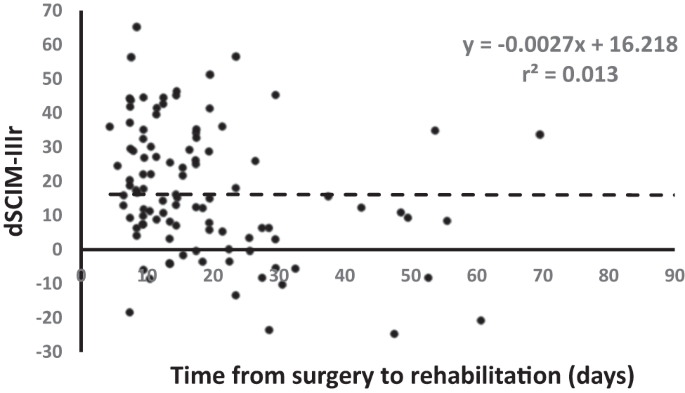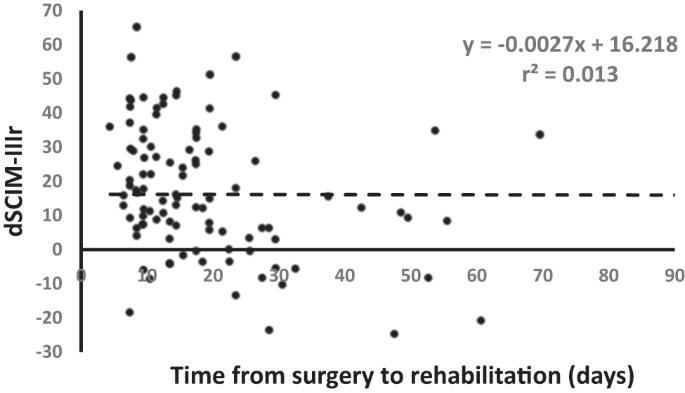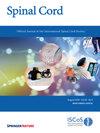The role of comprehensive rehabilitation in the care of degenerative cervical myelopathy
IF 2.1
4区 医学
Q3 CLINICAL NEUROLOGY
引用次数: 0
Abstract
Retrospective cohort study. To find out if comprehensive rehabilitation itself can improve daily performance in persons with DCM. The spinal department of a rehabilitation hospital. Data from 116 DCM inpatients who underwent comprehensive rehabilitation after spinal surgery were retrospectively analyzed. The definitions of the calculated outcome variables made possible analyses that distinguished the effect of rehabilitation from that of spinal surgery. Paired t-tests were used to compare admission with discharge outcomes and functional gains. Spearman’s correlations were used to assess relationships between performance gain during rehabilitation and between time from surgery to rehabilitation. The Spinal Cord Injury Ability Realization Measurement Index (SCI-ARMI) increased during rehabilitation from 57 (24) to 78 (19) (p < 0.001). The Spinal Cord Independence Measure 3rd version (SCIM III) gain attributed to neurological improvement (dSCIM-IIIn) was 6.3 (9.2), and that attributed to rehabilitation (dSCIM-IIIr) 16 (18.5) (p < 0.001). dSCIM-IIIr showed a rather weak negative correlation with time from spinal surgery to rehabilitation (r = −0.42, p < 0.001). The study showed, for the first time, that comprehensive rehabilitation can achieve considerable functional improvement for persons with DCM of any degree, beyond that of spinal surgery. Combined with previously published evidence, this indicates that comprehensive rehabilitation can be considered for persons with DCM of any functional degree, before surgery.


综合康复在治疗退行性颈椎脊髓病中的作用。
研究设计回顾性队列研究:研究背景:康复医院脊柱科:地点:一家康复医院的脊柱科:回顾性分析了 116 名脊柱手术后接受综合康复治疗的 DCM 住院患者的数据。计算结果变量的定义使分析能够区分康复效果和脊柱手术效果。采用配对 t 检验比较入院与出院的疗效和功能改善情况。斯皮尔曼相关性用于评估康复过程中的能力提高和从手术到康复的时间之间的关系:结果:脊髓损伤能力实现测量指数(SCI-ARMI)在康复期间从 57(24)增加到 78(19)(p rd 版本(SCIM III)),归因于神经系统改善的增益(dSCIM-IIIn)为 6.3(9.2),归因于康复的增益(dSCIM-IIIr)为 16(18.5)(p 结论:该研究首次显示,脊髓损伤患者在康复期间的能力实现指数(SCI-ARMI)从 57(24)增加到 78(19)(p rd 版本(SCIM III)):该研究首次表明,综合康复治疗可显著改善任何程度的 DCM 患者的功能,其效果超过脊柱手术。结合之前发表的证据,这表明任何功能程度的 DCM 患者都可以考虑在手术前进行综合康复治疗。
本文章由计算机程序翻译,如有差异,请以英文原文为准。
求助全文
约1分钟内获得全文
求助全文
来源期刊

Spinal cord
医学-临床神经学
CiteScore
4.50
自引率
9.10%
发文量
142
审稿时长
2 months
期刊介绍:
Spinal Cord is a specialised, international journal that has been publishing spinal cord related manuscripts since 1963. It appears monthly, online and in print, and accepts contributions on spinal cord anatomy, physiology, management of injury and disease, and the quality of life and life circumstances of people with a spinal cord injury. Spinal Cord is multi-disciplinary and publishes contributions across the entire spectrum of research ranging from basic science to applied clinical research. It focuses on high quality original research, systematic reviews and narrative reviews.
Spinal Cord''s sister journal Spinal Cord Series and Cases: Clinical Management in Spinal Cord Disorders publishes high quality case reports, small case series, pilot and retrospective studies perspectives, Pulse survey articles, Point-couterpoint articles, correspondences and book reviews. It specialises in material that addresses all aspects of life for persons with spinal cord injuries or disorders. For more information, please see the aims and scope of Spinal Cord Series and Cases.
 求助内容:
求助内容: 应助结果提醒方式:
应助结果提醒方式:


